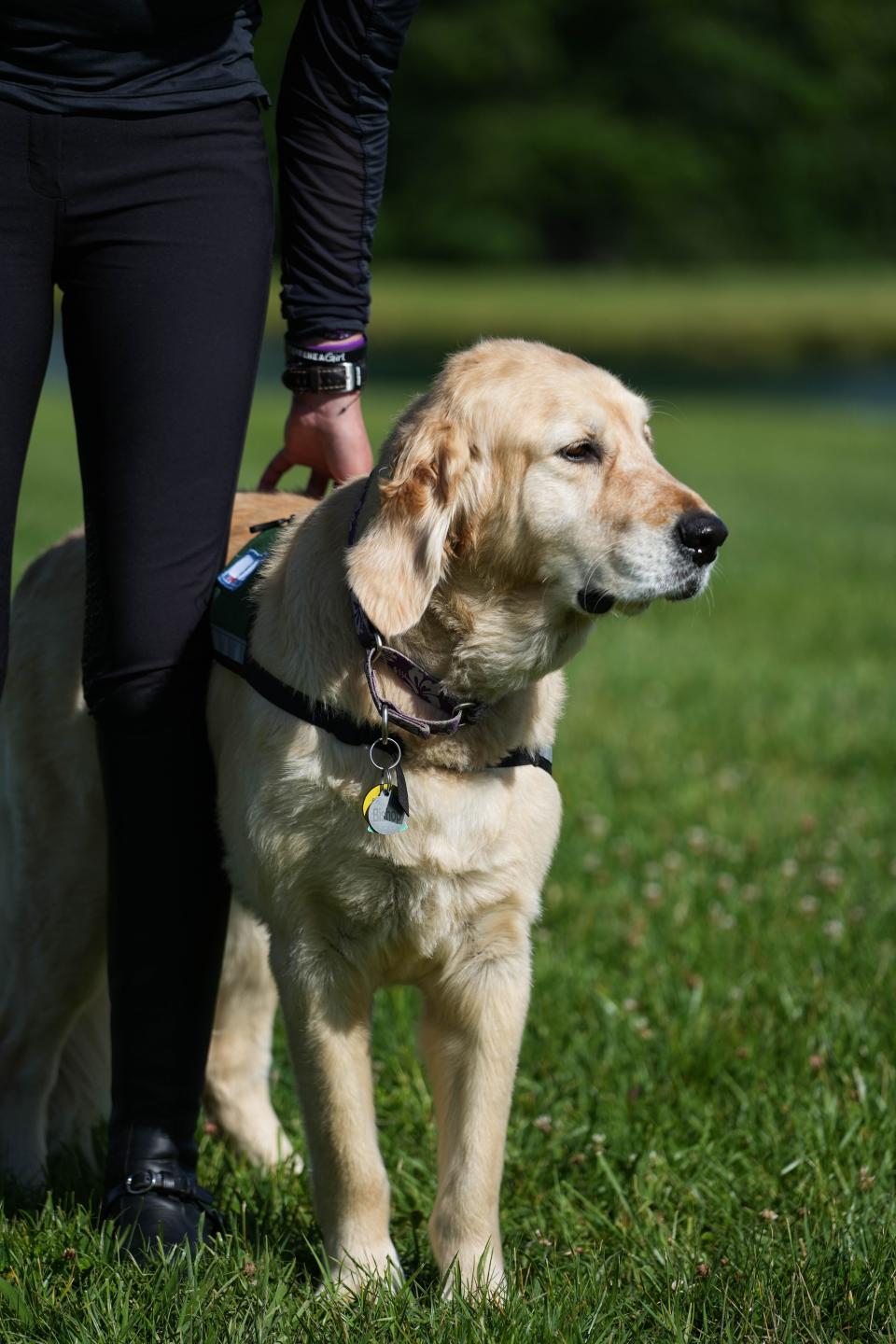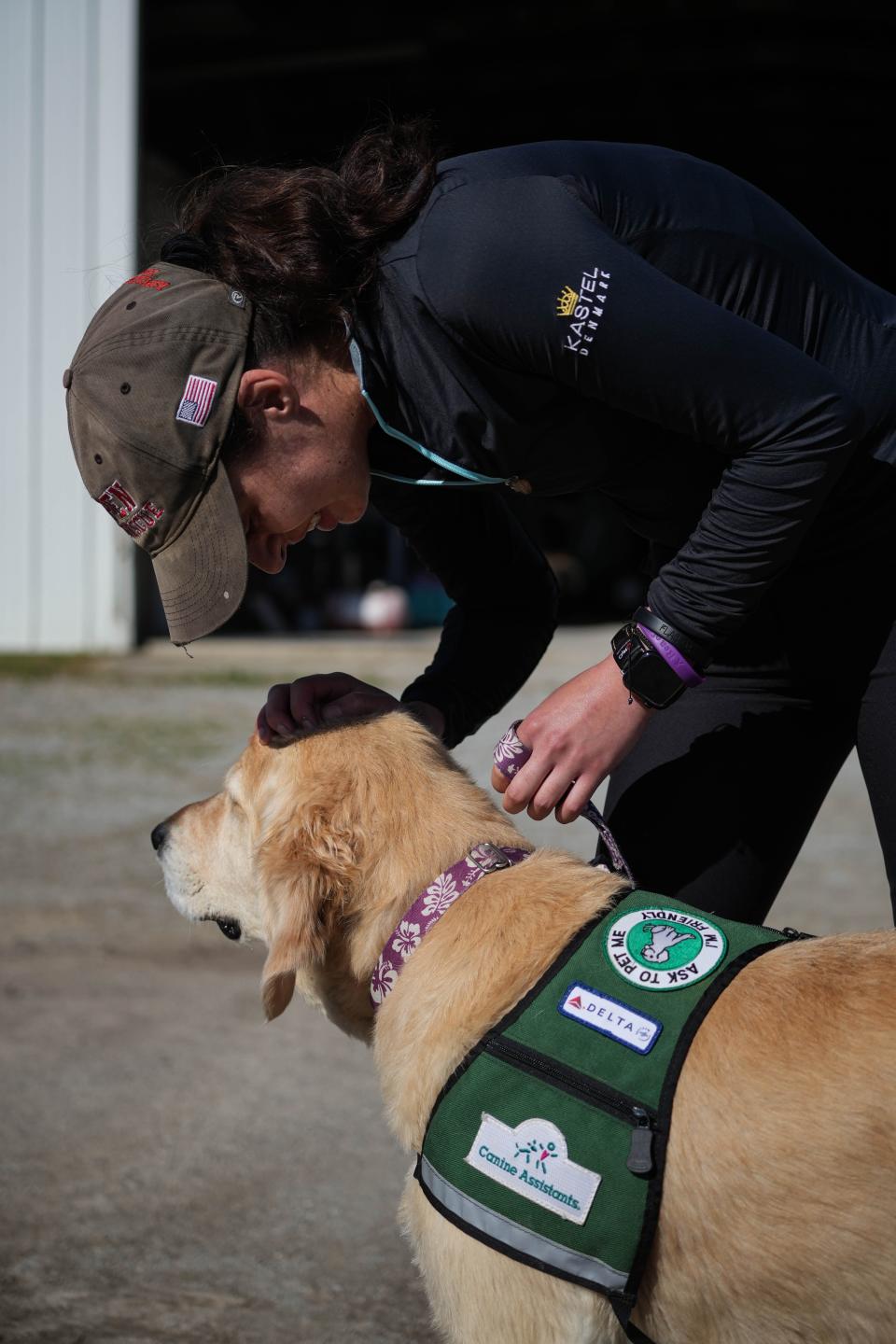Channing Seideman gracefully rides her 1,000-pound horse, Perla, at Batavia’s Majestic Farm. Nearby is a different animal: Seideman’s service dog, Bishop.
Bishop watches to make sure his 30-year-old owner is safe. The golden doodle can run for help if Seideman gets sick. He can even detect if Seideman is about to have a seizure and alert her.
Perla helps Seideman do what she loves. Bishop helps keep Seideman safe so she can live her life.
Seideman was diagnosed with epilepsy when she was 10 years old. The neurological condition, which is characterized by recurrent seizures, impacts about 65 million people globally. But, the kinds of seizures people experience and the severity of their condition vary. For Seideman, the disease changed her life.
Watching the athletic woman, you’d never guess that she spends continuous days bedridden. Or that she was so sick as a teen, she didn’t think she’d ever graduate from high school. Or that her seizures are so challenging and inconsistent, that they’ve made it impossible for her to hold down a job or live alone.
Throughout it all, Seideman found solace and safety in her dog. Seideman’s mom Kelly Hall said, “He brings comfort and peace.”
The seizures start
Seideman had her first seizure when she was nine and living in Colorado. Her dad, Rob Seideman, and she went to check out a cop car on their street. Likely triggered by the car’s flashing lights, Seideman’s brain experienced an uncontrolled burst of electric activity.
Rob saw her slumped over and unresponsive. “I had no idea if I’d see her or talk to her again,” he said.
Her next seizure occurred months later in 2003. This one was a tonic-clonic seizure, formerly known as a “grand mal” seizure. To the general public, it’s the ‘big one’ characterized by muscle stiffening and jerking, loss of consciousness and breathing impairment.

Because Seideman had now experienced two seizures in an otherwise healthy body, the doctors officially diagnosed her with epilepsy.
The family held out hope she would grow out of it. More than 50 out of 100 children outgrow their epilepsy. In children with new-onset seizures, 74 out of 100 become seizure-free within 2 years.
The odds were in Seideman’s favor.
But as time passed, her health progressively worsened. “We eventually ran out of medications to try,” her mom said.
In 2007, at age 13, Seideman was diagnosed with juvenile myoclonic epilepsy and told she would have epilepsy forever.
Meeting Georgie, her first service dog
Epilepsy changed Seideman’s world.
Her grades dropped from straight A’s to F’s. Seideman would miss so much school for doctor’s appointments it was hard to keep up. Her absence seizures –brief, sudden lapses of consciousness – which she described as forced daydreaming – made it challenging to retain information.
Socializing became difficult. Her friends now felt more like babysitters. Plus, the unexpectedness of seizures and the subsequent long recovery periods made it impossible to make plans.

She resented her epilepsy. “I didn’t want epilepsy to be visible. I didn’t want to make this disease visible,” Seideman said. “For me, epilepsy was ‘You do not speak the word ‘epilepsy’ around me. You do not say the word ‘seizure’ around me.'”
“I do not want anything to do with this,” she said. “This is not happening.”
She was hesitant to get a service dog for fear that would make her epilepsy even more visible.
But the opposite happened. As a junior in high school, when Seideman brought her first service dog, Georgie, to school, “I became invisible and the dog was all the attention,” Seideman said with a laugh. “It was not what I expected.”

Seideman said that Georgie made epilepsy seem “more approachable.” Georgie also could respond to Seideman in need. She could get the phone or a person for help or get medications.
Seideman showed up to riding competitions with more confidence now that she had Georgie’s support.
Seideman and Georgie also deeply bonded. “I leaned on her mentally and emotionally,” Seideman said. “I leaned on her hard.”
She added, “I wouldn’t have made it through school without Georgie.”
Losing Georgie, meeting Bishop
Seideman is just one of the thousands of people Canine Assistants has paired with service dogs in about three decades.
The Georgia-based nonprofit focuses on teaching the dogs and their owners to develop a strong bond −which reaps a variety of benefits.
“For people who have epilepsy, I think having a dog who can get someone in the event you’re having a seizure or dogs who are reliably anticipating the onset of a seizure to come, all of those things are lifesaving, potentially,” founder Jennifer Arnold said.

“But even in those cases,” she continued, “I think the greater benefit is derived from having with you all day, every day this individual who looks up at you and sees you as perfection.”
It’s a sentiment echoed by Seideman and her whole family.
When Georgie died in 2019, that loss was deeply felt by Seideman and her parents.
When Bishop came along six months later, he was welcomed with open arms. Like Georgie, Bishop improves Seideman’s quality of life, she said.

Today, Seideman sits in a Majestic Farm barn, talking about her experience. In front of her is a large corral where people ride horses. Perla is in a stall in the other room.
Bishop is closer. He sits at Seideman’s feet, listening to her talk. As always, he is never far away.
He is right there for her. Always.
This article originally appeared on Cincinnati Enquirer: Dogs can save people with epilepsy. Just ask this Milford woman
Signup bonus from




